Mineralogy and Geochemistry of JingFenCui (Rhodonite Jade) Deposit from Beijing, China
Abstract
:1. Introduction
2. Geological Setting
3. Samples and Methods
4. Results
4.1. Petrographic Characterization
4.1.1. Texture and Compositions
4.1.2. Backscattered Electron (BSE) Observations
4.2. Electron Probe Microanalysis
4.2.1. Manganocalcite
4.2.2. Spessartine
4.2.3. Rhodonite
4.2.4. Pyroxene
4.2.5. Amphibole
4.3. Trace Elements and REE in Rhodonite, Amphibole, and Galena
5. Discussion
6. Conclusions
Author Contributions
Funding
Institutional Review Board Statement
Informed Consent Statement
Data Availability Statement
Acknowledgments
Conflicts of Interest
References
- Han, X.L. A Study on Technological Characteristics of Mn-Ag Multimetal Ore and Occurrence State of Silver in Changpin. China’s Manganese Ind. 1999, 1, 23–26. [Google Scholar]
- Yu, X.Y.; Long, Z.Y.; Zhang, Y.; Qin, L.J.; Zhang, C.; Xie, Z.R.; Wu, Y.-R.; Yan, Y.; Wu, M.-K.; Wan, J.-X. Overview of Gemstone Resources in China. Crystals 2021, 11, 1189. [Google Scholar] [CrossRef]
- Wang, S.Q. Geological and geochemical characteristics and genesis of Xihucun manganese-silver polymetallic deposit in Beijing. Miner. Depos. 1998, 17, 553–556. [Google Scholar]
- Di, Y.L. Magma Mixing and Its Origin of Xuejiashiliang Complex in Changping, Beijing. Master’s Thesis, University of Geosciences (Beijing), Beijing, China, 2017. [Google Scholar]
- Su, S.; Niu, Y.; Deng, J.; Liu, C.; Zhao, G.; Zhao, X. Petrology and geochronology of Xuejashiliang igneous complex and their genetic link to the lithospheric thinning during the Yanshanian orogenesis in eastern China. Lithos 2007, 96, 90–107. [Google Scholar] [CrossRef]
- An, Z.; Chen, X.; Ding, W.; Zhong, Y. The Gemology Characteristics and Color-causing of Peking Rhodonite in Changping Disctirct, Beijing. J. Beijing Polytech. Coll. 2013, 4, 11–15. [Google Scholar]
- Li, K.S. The geological characteristics and the genesis of the rhodonite deposit in ShaanXi province. Geol. Shaanxi 1992, 2, 23–30. [Google Scholar]
- Deng, M.; Xu, R.; Wang, P.; Sun, B.; Zeng, L.; Yu, H.; Wang, T.; Sha, J. The rhodonite and manganese clinopyroxene of Makeng, south of Fujian Provence. Geol. Rev. 1980, 26, 208–216. [Google Scholar]
- Deng, M.; Xu, R.; Wang, P.; Sun, B.; Zeng, L.; Yu, H.; Wang, T.; Sha, J. Geochemistry of the rhodonite in the Luziyuan Pb-Zn-Fe polymetallic deposit in West Yunnan and their genesis significance. Acta Petrol. Sin. 2016, 32, 2248–2264. [Google Scholar]
- Deer, W.A. Rock-Forming Minerals, 2nd ed.; Longman: London, UK, 1978; Volume 2A. [Google Scholar]
- Morimoto, N. Nomenclature of pyroxenes. Miner. Pet. 1988, 39, 55–76. [Google Scholar] [CrossRef]
- Liu, X.F.; Wang, L.; Li, H.; Liu, J.; Zhao, F.F.; Lu, Q.X.; Hu, L. Systematic mineralogical classifications and nomencaltures of amphibole and pyroxene group minerals. Acta Mineral. Sin. 2015, 35, 19–28. [Google Scholar]
- Andrew, J.L. An Excel spreadsheet to classify chemical analyses of amphiboles following the IMA 2012 recommendations. Comput. Geosci. 2014, 62, 1–11. [Google Scholar] [CrossRef]
- Leake, B.E. Nomenclature of amphiboles. Mineral. Mag. 1978, 42, 533–563. [Google Scholar] [CrossRef]
- Wang, L.B. Nomenclature of amphiboles: Report of the Subcom-mittee on Amphiboles of the International Mineralogical Association, Commission on New Minerals and Mineral Names. Acta Petrol. Mineral. 2001, 20, 84–100. [Google Scholar]
- LeaLeake, B.E.; Woolley, A.R.; Birch, W.D.; Burke, E.A.; Ferraris, G.; Grice, J.D.; Hawthorne, F.C.; Kisch, H.J.; Krivovichev, V.G.; Schumacher, J.C.; et al. Nomenclature of amphiboles: Additions and revisions to the International Mineralogical Association’s 1997 recommendations. Can. Mineral. 2003, 41, 1355–1362. [Google Scholar] [CrossRef]
- Sun, S.S.; McDonough, W.F. Chemical and isotopic systematics of oceanic basalts: Implications for mantle composition and processes. Geol. Soc. Lond. Spec. Publ. 1989, 42, 313–345. [Google Scholar] [CrossRef]
- Boynton, W.V. Rare Earth Element Geochemistry; Henderson, P., Ed.; Elsevier: Amsterdam, The Netherlands, 1984; pp. 63–114. [Google Scholar]
- Wang, Y. Magmatic response to the orogenic collapse: An example from the Xuejiashiliang-Heishanzhai magmatie complex in Beiing. Geotecton. Metallog. 2014, 38, 656–669. [Google Scholar]
- Liu, F.; Yang, J.; Li, T.; Chen, S.; Xu, X.; Li, J.; Jia, Y. Geochemical characteristics of Late Carboniferous volcanic rocks in northern Tianshan, Xinjiang, and their geological significance. Geol. China 2011, 38, 868–889. [Google Scholar]
- Liu, F.; Su, S.G.; Yu, X.Y.; Liang, F.H.; Hu, Y.; Niu, X.L. Characteristics and petrogenesis of zoned amphiboles in Wengeqi mafic-ultramafic complex, Inner Mongolia. Earth Sci. Front. 2013, 20, 206–222. [Google Scholar] [CrossRef]
- Deng, M.; Li, W.; Wen, H.; Cang, F.; Wang, P.; Liu, C.; Xu, R.; Zeng, L.; Liu, X.; Liu, W.; et al. The finding and prospecting signifcance of rhodonite in the Luziyuan lead-zinc polymetallic ore deposit in Zhenkang, Western Yunnan. Geol. Bull. China 2013, 32, 1867–1869. [Google Scholar]
- Zhao, Y.M.; Li, D.X.; Dong, Y.G. Further discussion on Pb-Zn-Ag-bearing manganoan skar formation. Miner. Depos. 2002, 21, 548–552. [Google Scholar]
- Li, D.X.; Zhao, Y.M. Skarn mineralization zonation and Fluid Evolution in the Jiaoli Deposit, Jiangxi Province. Geol. Rev. 2004, 1, 16–24. [Google Scholar]
- Zhao, Y.M.; Zhang, Y.N.; Lin, W.W. Characteristics of Pyoxenes and Pyroxenoids in Skarn deposits of China and their Relationship with Metallization. Miner. Depos. 1997, 4, 318–329. [Google Scholar]
- Mao, J.W.; Li, Y.H.; Wang, A.P. Manganoan skarn in the Shizhuyuan polymatallie tungsten deposit, Hunan Province. Miner. Depos. 1994, 13, 38–47. [Google Scholar]
- Su, S.G.; Deng, J.F.; Zhao, G.C. Characteristics, origin and resource property of Xuejiashiliang complex, Beijing area and their relationship with the way of lithospheric thinning. Earth Sci. Front. 2006, 13, 148–157. [Google Scholar]
- Yang, F.; Mao, J.; Xu, L.; Zhang, Y.; Liu, F.; Huang, C.; Zhou, G.; Liu, G.; Dai, J. REE geochemistry of the Mengku iron deposit, Xinjiang, and its indication for iron mineralization. Acta Petrol. Sin. 2007, 23, 2443–2456. [Google Scholar]
- Liu, Y.J.; Cao, L.M.; Li, Z.L. Element Geochemistry; Science Press: Beijing, China, 1984; Volume 83, p. 304. [Google Scholar]
- Nozaki, Y.; Zhang, J.; Amakawa, H. The fractionation between Y and Ho in the marine environment. Earth Planet. Sci. Lett. 1997, 148, 329–340. [Google Scholar] [CrossRef]
- Bolhar, R.; Van Kranendonl, M.J.; Kamber, B.S. A trace element study of siderte-jasper banded iron formation in the 3.45 Ga Warrawoona Group, Pilbara Graton-formation from hydrothermal fluids and shallow seawater. Precambrian Res. 2005, 137, 93–114. [Google Scholar]
- Bau, M.; Dulski, P. Comparing yttrium and rare earths in hydrothermal fluids from the Mid-Atlantic Ridge: Implications for Y and REE behaviour during near-vent mixing and for the Y/Ho ratio of Proterozoie seawater. Chem. Geol. 1999, 155, 77–90. [Google Scholar] [CrossRef]
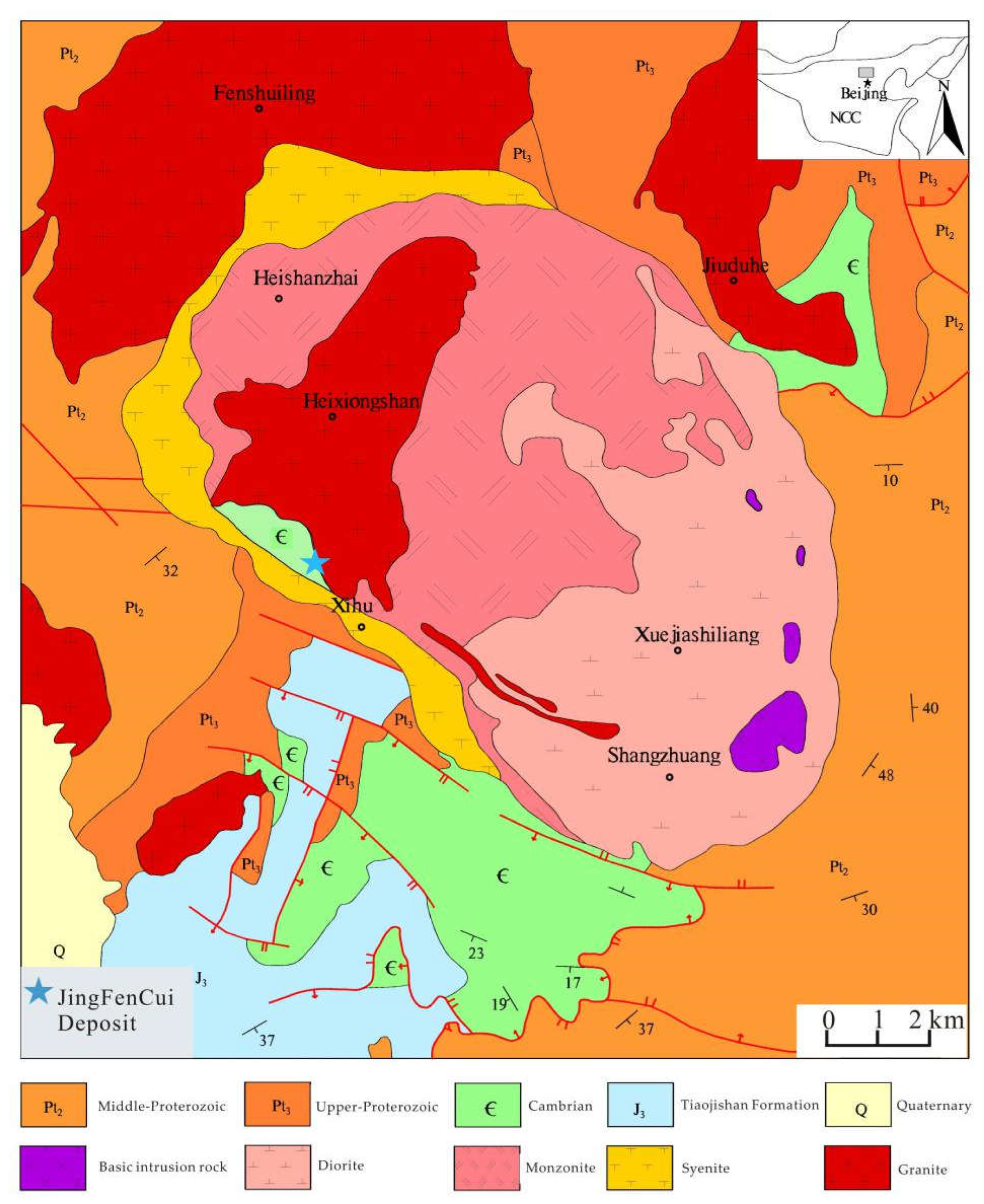
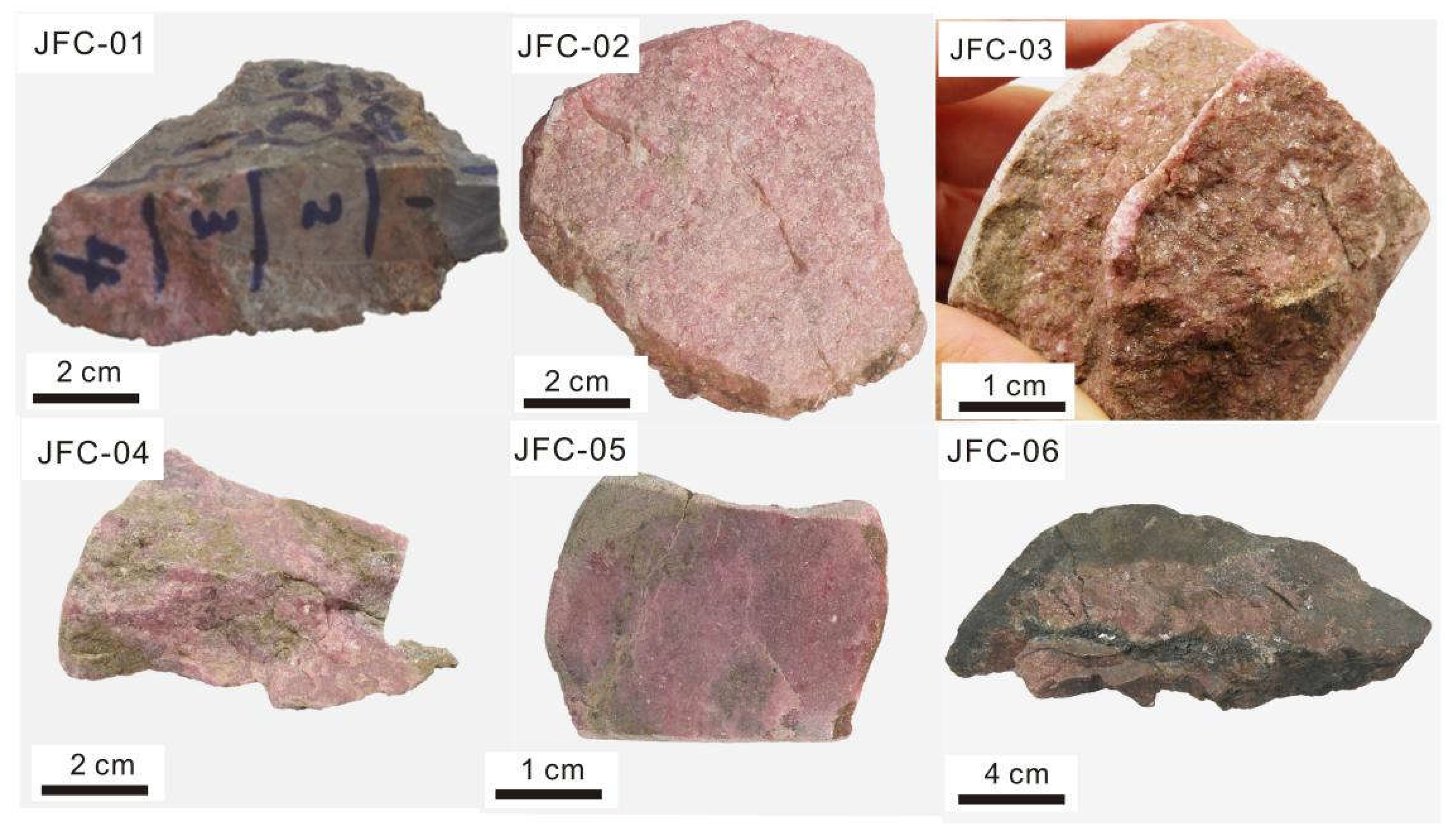
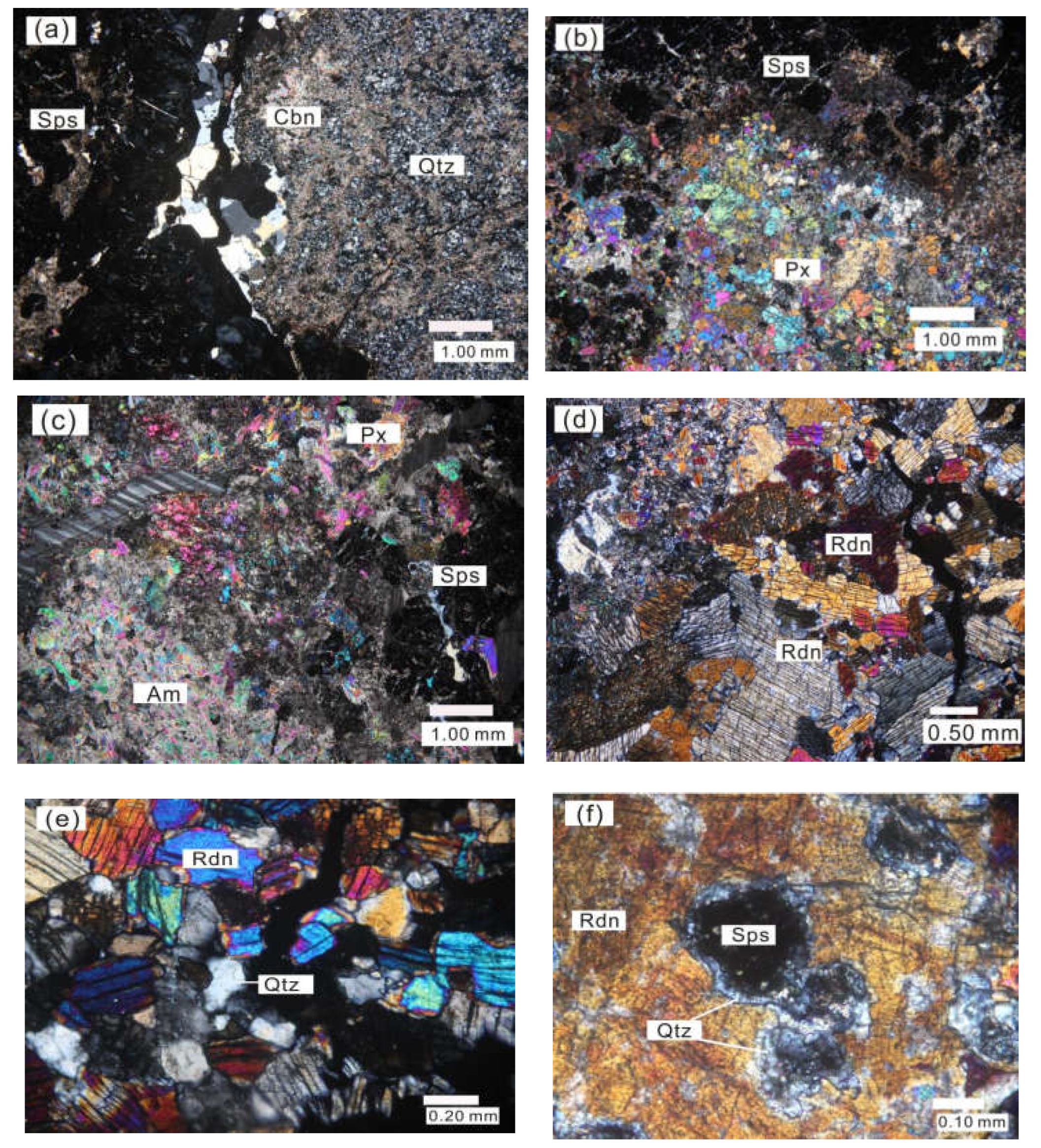

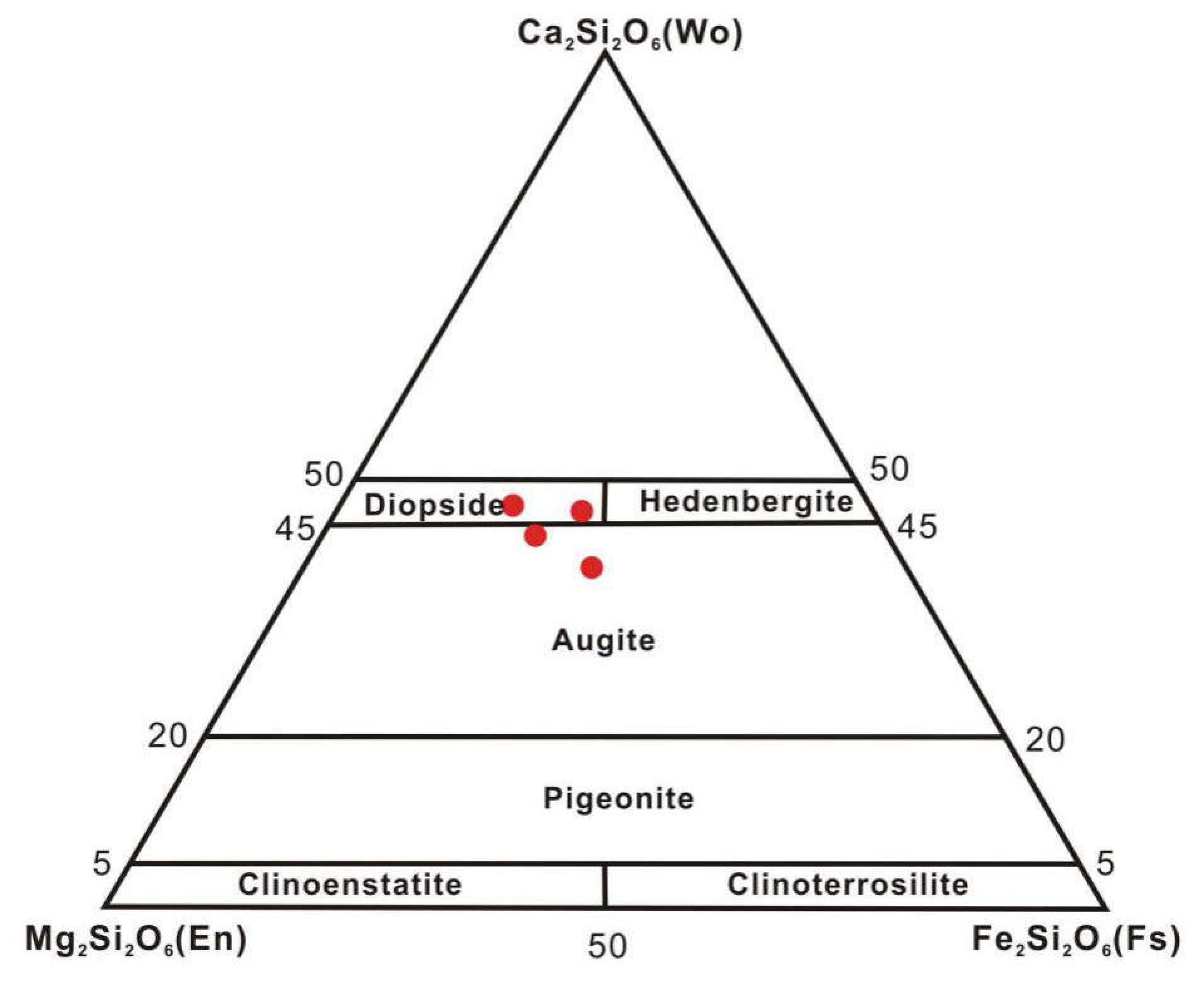
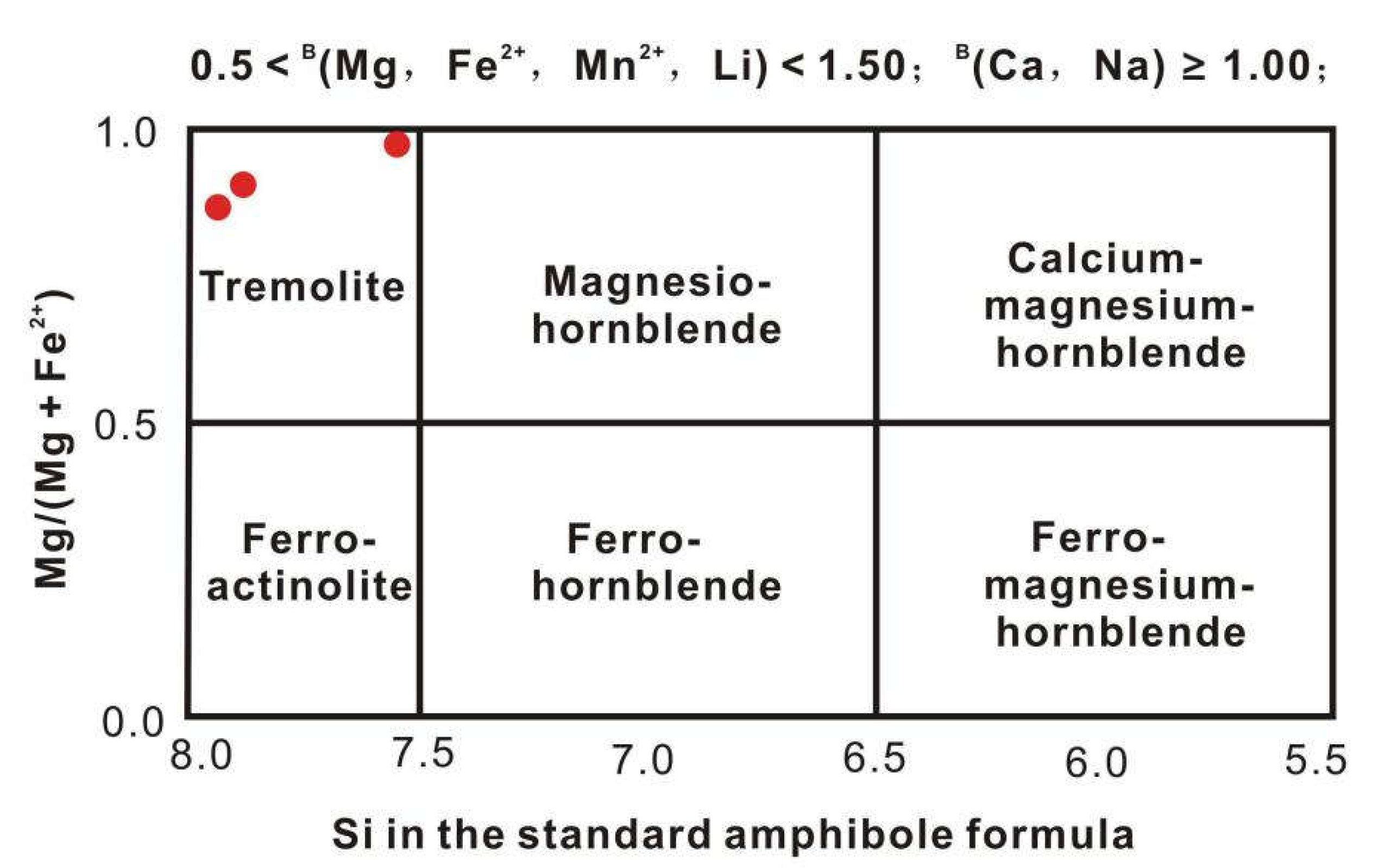
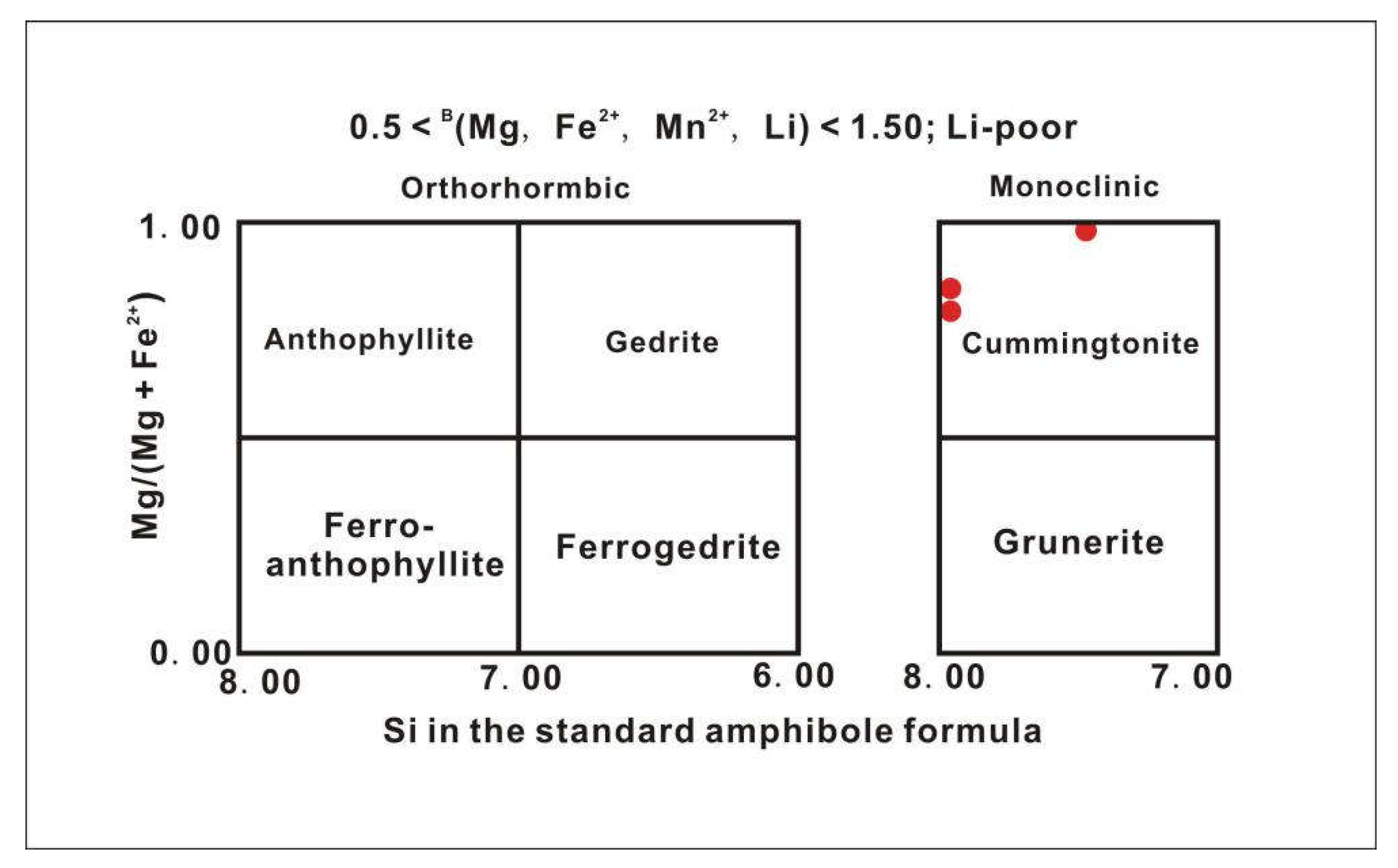
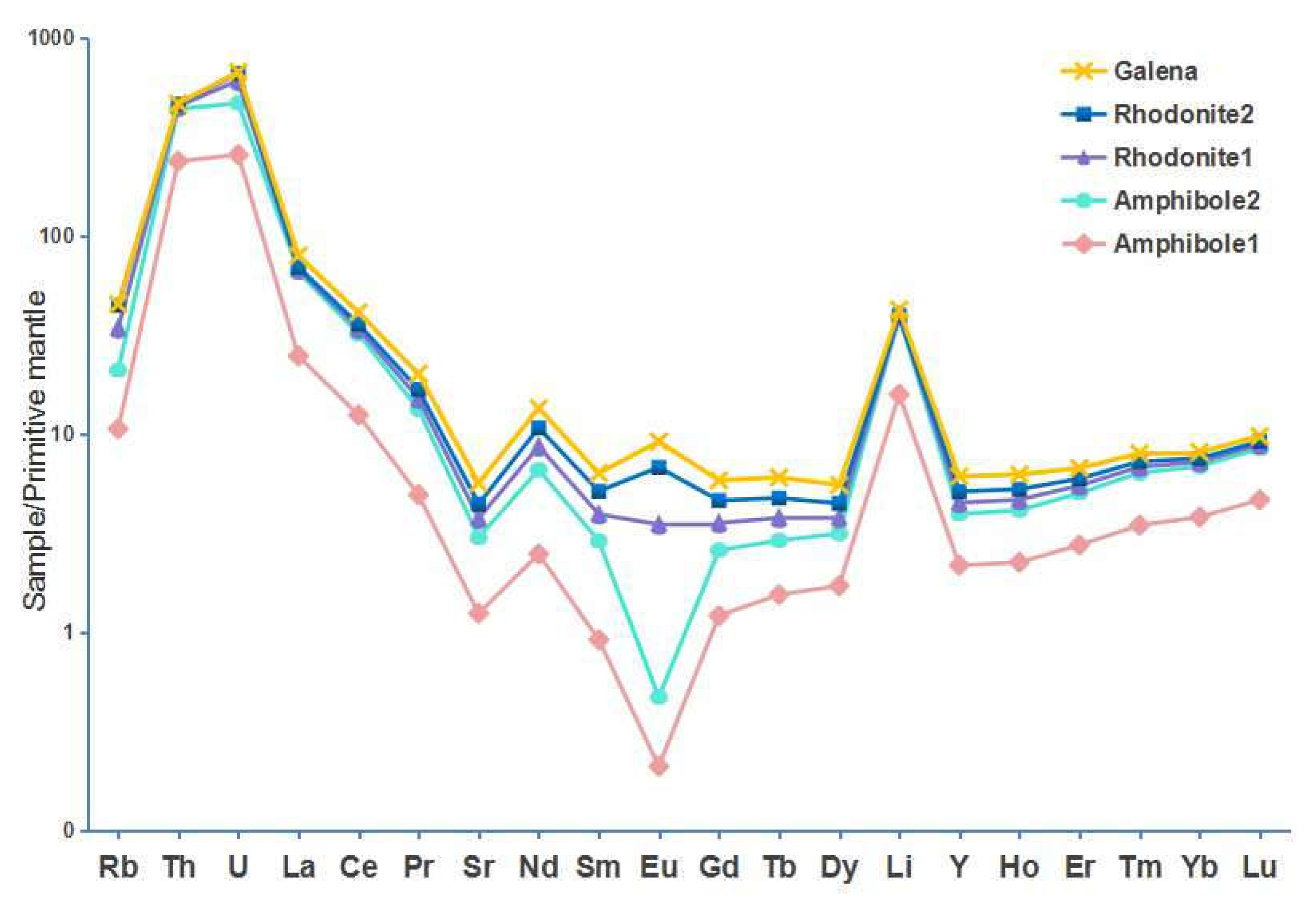
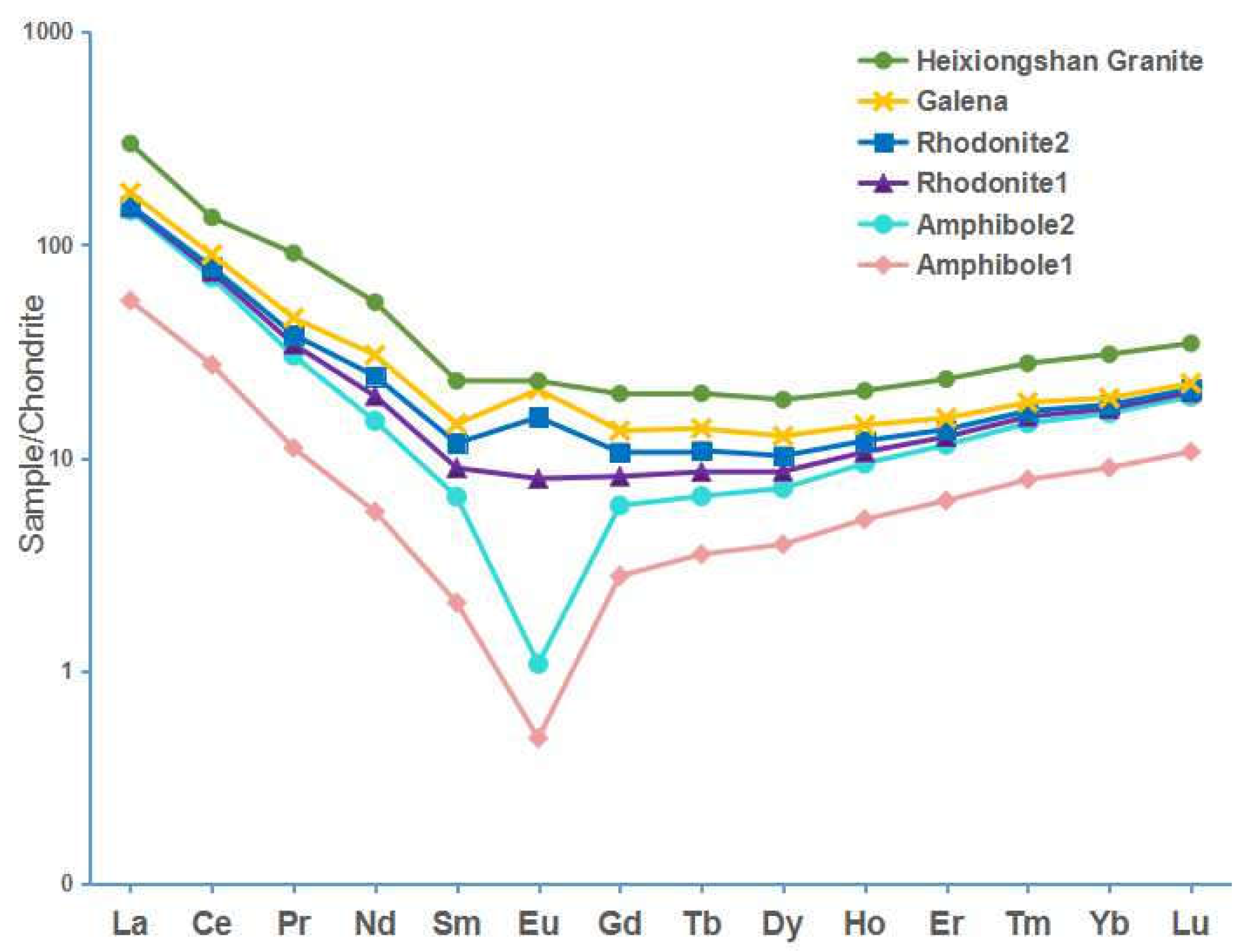
| Samples | Mineral | SiO2 | FeO | MnO | MgO | CaO | Na2O | K2O | Al2O3 | TiO2 | Total |
|---|---|---|---|---|---|---|---|---|---|---|---|
| JFC1-1 | Manganocalcite | 0.21 | 0.69 | 13.17 | 0.61 | 45.49 | N.D. | N.D. | N.D. | N.D. | 60.17 |
| JFC3-8 | Manganocalcite | N.D. | 0.36 | 8.18 | 0.19 | 47.95 | 0.02 | 0.01 | N.D. | 0.36 | 56.71 |
| JFC1-2 | Spessartine | 33.76 | 4.21 | 33.73 | N.D. | 10.41 | N.D. | N.D. | 16.94 | 0.64 | 99.68 |
| JFC1-3 | Spessartine | 31.56 | 7.01 | 39.49 | 1.34 | 4.03 | N.D. | N.D. | 16.94 | 0.22 | 100.59 |
| JFC1-4 | Augite | 47.8 | 7.9 | 13.65 | 10.77 | 19.06 | N.D. | N.D. | N.D. | 0.19 | 99.36 |
| JFC2-2 | Diopside | 49.72 | 5.85 | 10.16 | 12.15 | 22.24 | 0.08 | 0.15 | N.D. | N.D. | 100.36 |
| JFC2-4 | Diopside | 51.12 | 4.83 | 11.33 | 10.14 | 21.56 | 0.08 | 0.13 | 0.06 | 0.1 | 99.34 |
| JFC2-5 | Augite | 52.34 | 4.75 | 9.34 | 12.18 | 20.91 | 0.28 | 0.11 | N.D. | N.D. | 99.91 |
| JFC2-1 | Manganotremolite | 52.92 | 7.79 | 14.22 | 17.09 | 6.95 | 0.88 | 0.46 | N.D. | N.D. | 100.31 |
| JFC3-2 | clino-suenoite | 52.23 | 7.56 | 16.13 | 18.08 | 5.26 | N.D. | 0.18 | 0.08 | N.D. | 99.53 |
| JFC3-4 | clino-suenoite | 55.2 | 7.99 | 15.52 | 16.42 | 4.08 | 0.11 | 0.16 | N.D. | N.D. | 99.49 |
| JFC3-5 | Manganotremolite | 56.22 | 5.52 | 12.98 | 18.08 | 6.61 | 0.19 | 0.22 | 0.11 | 0.04 | 99.96 |
| JFC3-6 | Manganotremolite | 56.21 | 5.29 | 11.09 | 19.66 | 6.65 | 0.12 | 0.03 | 0.31 | 0.08 | 99.44 |
| JFC3-7 | clino-suenoite | 56.13 | 6.3 | 12.63 | 17.68 | 5.86 | 0.21 | 0.08 | 0.37 | 0.02 | 99.29 |
| JFC4-1 | Rhodonite | 38.59 | 6.32 | 47.18 | 3.1 | 4.61 | 0.1 | 0.04 | N.D. | 0.05 | 100 |
| JFC5-1 | Rhodonite | 38.75 | 5.62 | 46.62 | 1.37 | 7.62 | 0.17 | N.D. | N.D. | N.D. | 100.16 |
| Shangxian, Shaanxi [7] | Rhodonite | 40.92 | 2.39 | 40.79 | 2.13 | 5.45 | 0.02 | N.D. | 1.32 | 0.006 | 99.24 |
| Makeng, Fujian [8] | Bustamite | 47.72 | 4.47 | 27.98 | 1.09 | 16.99 | N.D. | N.D. | 0.1 | 0.01 | 98.36 |
| Luziyuan, Yunnan [9] | Rhodonite | 47.01 | 2.85 | 40.19 | 0.28 | 8.17 | N.D. | N.D. | 0.04 | 0.02 | 98.55 |
| India [10] | Rhodonite | 45.46 | 0.96 | 50.54 | 0.55 | 2.25 | N.D. | N.D. | 0.27 | N.D. | 100.03 |
| New Zealand [10] | Rhodonite | 46.42 | 1.60 | 47.62 | 0.92 | 3.26 | N.D. | N.D. | 0.07 | N.D. | 100.07 |
| Sweden [10] | Rhodonite | 47.78 | 14.62 | 29.20 | 1.93 | 6.55 | N.D. | N.D. | 0.08 | N.D. | 100.05 |
| Mineral | Amphibole1 | Amphibole2 | Rhodonite1 | Rhodonite2 | Galena | Heixiongshan Granite [19] |
|---|---|---|---|---|---|---|
| Li | 25.3 | 37.3 | 0.59 | 0.15 | 4.32 | N.D. |
| Be | 0.14 | 0.13 | 2.48 | 1.31 | 0.02 | N.D. |
| Sc | 6.40 | 6.55 | 0.77 | 0.49 | 0.55 | 1.33 |
| Cr | 5.07 | 5.84 | 3.68 | 4.05 | 2.70 | 15.0 |
| Co | 0.00 | 0.20 | 0.87 | 0.34 | 0.62 | 0.27 |
| Ni | 0.82 | 0.95 | 2.34 | 1.23 | 1.87 | 4.75 |
| Cu | 2.84 | 1.07 | 1.98 | 3.07 | 182 | N.D. |
| Ga | 16.5 | 18.6 | 4.52 | 3.90 | 3.78 | 22.1 |
| Rb | 6.74 | 6.56 | 8.37 | 6.60 | 0.35 | 185 |
| Sr | 26.2 | 37.2 | 15.6 | 14.4 | 25.9 | 19 |
| Zn | 17.2 | 7.61 | 1107 | 1393 | 2803 | N.D. |
| Pb | 175 | 225 | 366 | 523 | 14962 | 24.8 |
| Th | 20.2 | 16.9 | 1.14 | 0.91 | 0.36 | 24.4 |
| U | 5.37 | 4.41 | 2.93 | 1.13 | 0.22 | 4.39 |
| La | 17.0 | 28.0 | 1.49 | 1.05 | 6.97 | 38.3 |
| Ce | 22.1 | 34.7 | 3.60 | 3.12 | 9.34 | 36.0 |
| Pr | 1.36 | 2.32 | 0.49 | 0.46 | 0.92 | 5.63 |
| Nd | 3.35 | 5.59 | 2.77 | 2.81 | 3.72 | 14.1 |
| Sm | 0.41 | 0.87 | 0.47 | 0.54 | 0.53 | 1.67 |
| Eu | 0.04 | 0.04 | 0.51 | 0.55 | 0.40 | 0.15 |
| Gd | 0.72 | 0.82 | 0.57 | 0.63 | 0.73 | 1.70 |
| Tb | 0.17 | 0.15 | 0.09 | 0.11 | 0.14 | 0.30 |
| Dy | 1.26 | 1.05 | 0.46 | 0.51 | 0.78 | 1.97 |
| Ho | 0.37 | 0.31 | 0.09 | 0.10 | 0.16 | 0.46 |
| Er | 1.32 | 1.09 | 0.22 | 0.22 | 0.38 | 1.69 |
| Tm | 0.26 | 0.21 | 0.03 | 0.03 | 0.05 | 0.31 |
| Yb | 1.88 | 1.50 | 0.17 | 0.15 | 0.28 | 2.41 |
| Lu | 0.34 | 0.28 | 0.03 | 0.02 | 0.04 | 0.39 |
| Y | 9.89 | 8.06 | 2.49 | 2.82 | 4.50 | 13.8 |
| ∑REE | 50.5 | 76.9 | 11.0 | 10.3 | 24.4 | 105 |
| LREE | 44.2 | 71.5 | 9.33 | 8.53 | 21.9 | 95.8 |
| HREE | 6.32 | 5.42 | 1.67 | 1.77 | 2.56 | 9.23 |
| LREE/HREE | 7.00 | 13.2 | 5.57 | 4.81 | 8.53 | 10.4 |
| δEu | 0.20 | 0.16 | 3.01 | 2.90 | 1.96 | 0.27 |
| δCe | 11.2 | 11.2 | 1.94 | 1.49 | 4.18 | 5.89 |
| Y/Ho | 26.8 | 26.4 | 27.9 | 28.5 | 28.0 | 29.9 |
Publisher’s Note: MDPI stays neutral with regard to jurisdictional claims in published maps and institutional affiliations. |
© 2022 by the authors. Licensee MDPI, Basel, Switzerland. This article is an open access article distributed under the terms and conditions of the Creative Commons Attribution (CC BY) license (https://creativecommons.org/licenses/by/4.0/).
Share and Cite
Kang, Z.-J.; Shi, G.-H.; Lei, W.-Y.; An, C.-X.; Liu, L.; Liu, S.-H.; Lu, F.; Xu, L. Mineralogy and Geochemistry of JingFenCui (Rhodonite Jade) Deposit from Beijing, China. Crystals 2022, 12, 483. https://doi.org/10.3390/cryst12040483
Kang Z-J, Shi G-H, Lei W-Y, An C-X, Liu L, Liu S-H, Lu F, Xu L. Mineralogy and Geochemistry of JingFenCui (Rhodonite Jade) Deposit from Beijing, China. Crystals. 2022; 12(4):483. https://doi.org/10.3390/cryst12040483
Chicago/Turabian StyleKang, Zhi-Juan, Guang-Hai Shi, Wei-Yan Lei, Cai-Xiu An, Lu Liu, Shu-Hong Liu, Feng Lu, and Lin Xu. 2022. "Mineralogy and Geochemistry of JingFenCui (Rhodonite Jade) Deposit from Beijing, China" Crystals 12, no. 4: 483. https://doi.org/10.3390/cryst12040483
APA StyleKang, Z.-J., Shi, G.-H., Lei, W.-Y., An, C.-X., Liu, L., Liu, S.-H., Lu, F., & Xu, L. (2022). Mineralogy and Geochemistry of JingFenCui (Rhodonite Jade) Deposit from Beijing, China. Crystals, 12(4), 483. https://doi.org/10.3390/cryst12040483







